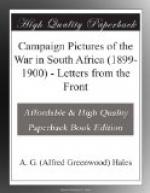As I rode from position to position our fellows greeted me with the cry: “Any news, sir? Heard if we are going to have a go at ’em with the spoons (bayonets)?” One midget, a bugler kiddie, so small that an ordinary maid-of-all-work could comfortably lay him across her knee and spank him, yawned as he knelt in the grass, and desired to know when “we was goin’ ter ‘ave some real bloomin’ fightin’. ‘E was tired of them bloomin’ guns, ’e was; they made his carmine ’ead ache with their blanky noise. ’E didn’t call that fightin’; ’e called it an adjective waste of good hammunition. ’E liked gettin’ up to ’is man, fair ’nd square, ‘nd knockin’ ’ell out of ’im.” He meant it, too, the little beggar, and I could not help laughing at him when I considered that lots of the old fighting Boers I had seen could have dropped the midget into their lunch bags, and not have noticed his weight.
The Yeomanry did a lot of useful work, and are as eager for fight as a bull ant on a hot plate. They are as good as any men I have seen in Africa, full of ginger, good horsemen, wear-and-tear, cut-and-come-again sort of men. They adapt themselves to circumstances readily, are jolly and good-humoured under trying circumstances. Their officers are, as a rule, first-class soldiers, equal to any emergency. On Tuesday the Boers kept their guns going at a great rate, and we really thought that they had made up their minds to see the thing right out at all costs. Personally I did not for a moment think that they were ignorant of General French’s rapid advance. I do not believe it possible for any large body of hostile troops to move in South Africa without the Boers being thoroughly cognisant of every detail connected with the move, partly because they are the most perfect scouts in the world, and partly because the scattered population on every hand is positively favourable to them. Our artillery dropped a storm of shells during the day, and that night it was whispered in camp that there was to be a general attack next morning. On Tuesday evening General French advanced right on to the Boer rear, and some smart fighting took place, the enemy suffering considerably, though our losses were small.




